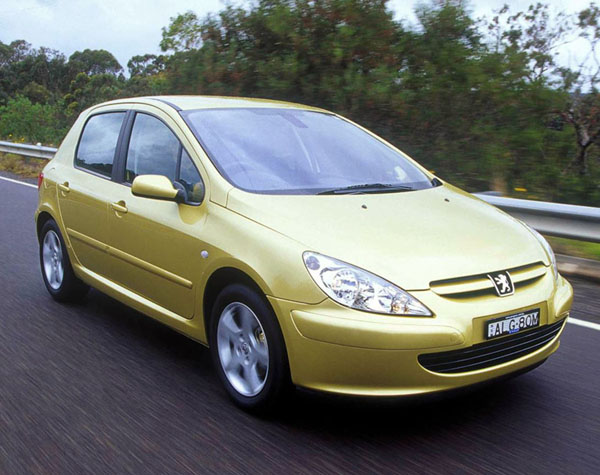The very French Peugeot 307 is stylish machine, though it retains a fair touch of conservatism in its shape to try and make it a timeless design. That has succeeded, the 307 reached us downunder way back in December 2001 and still looks fashionable enough today.
The Europeans frequently use Peugeot 307s as family transport, partially because of the extreme crowding in French cities and town, but also due to the very high cost of fuel. In Australia the 307 usually bought by couples or singles, though some may use it when the familiar are still young.
There’s not really enough space for four adults for extended use. To get good rear seat legroom you may have to move the front seats forward a couple of notches.
The front seats are large and proved the sort of comfort is what the French have long demanded. While the emphasis is on the comfort side of the equation, the handling of the Peugeot 307 isn’t too bad.
However, some keen drivers say it they are disappointed that the 307doesn’t have the feedback or dynamic response of the smaller 306 that it replaced.
The boot of the 307 is large and simple to load and can be extended by folding the rear seats in different sections. If you want extra luggage room a station wagon joined the five-door hatch in October 2003.
With the facelifted model from October 2005 the Peugeot 307 received the ‘big-grille’ look that had created such a stir with the launch of the Peugeot 407.
The big-grille Peugeot 307s are arguably the ones to go for if your budget is up to them as they had the handling and steering tidied up at the same time as the looks were changed. Having said that, the heavily facelifted Peugeot 308, due in Australia early in 2015 has taken a new, more subtle direction in styling.
A coupe-cabriolet version, the Peugeot 307 CC, arrived in February 2004. It’s a nice looking car with the top down, though as is often the way in this class the bulky tail doesn’t do a lot for the looks. As a matter of interest, Peugeot can claim to be the inventors of the folding hardtop, having come up with the practical design in the 1930s.
Petrol engines are also offered in 1.6 and 2.0-litre capacities. These engines are smooth enough in their own right, but somehow don’t quite manage the silkiness of their Japanese competitors.
Turbo-diesel engines have been strong in the Peugeot lineup in Australia for many years, since long before other European marques started to push them here. These days a large percentage of buyers choose them. You can buy diesels in 1.6 and 2.0-litre capacities. Even the smaller unit gives reasonable performance.
Petrol engines are sold with either a five-speed manual or four-speed automatic transmission. At this stage the diesels come only with manual gearboxes, five ratios in some and six in others, but an automatic transmission turbo-diesel is soon to hit the new-car scene.
Peugeots are built to a reasonably high standard. If you are moving up to a European car after spending years in low-cost Japanese ones you may strike more problems than you are accustomed to. However, things improved significantly during the lifetime of the 307 and we don’t hear of many complaints these days.
Peugeot has consistently maintained a strong presence in Australia for many years, which means they have good resale values as well as a well-organised dealer network. Naturally, there’s an emphasis on dealerships in metropolitan areas, but Peugeot is more widespread than a lot of other European marques due to it’s appeal to those who want a comfortable car for country use.
We haven’t heard any real complaints about the cost of servicing, repairs or spare parts for Peugeots. Even unusual parts generally seem to be delivered within a working day or so of being ordered.
The Peugeot 307 is a reasonably simple car in its mechanical layout. Routine servicing can be done by the owner; it’s always wise for them to have a workshop manual before opening the bonnet. However the amateur mechanic should not attempt major repairs.
Insurance costs are about average for an imported car in this class. Shop around as there can be quite a variation between insurance companies, but make sure you’re doing an exact comparison from company to company.
WHAT TO LOOK FOR
Check that the engine starts easily and idles relatively smoothly. It should accelerate the car without hesitation even from low revs and not be too noisy or harsh while doing so.
Watch for an immediate puff of smoke if the engine is suddenly asked to work hard. Some smoke is acceptable in a turbo-diesel, but it shouldn’t last for more than a couple of seconds. Any smoke in a petrol engine’s exhaust is likely to spell trouble.
Manual gearboxes are generally long lasting but one which is reluctant to change down from a high gear when rushed may be in trouble. On the other hand it might just be that the clutch needs adjusting.
Automatics should change quickly and not hold onto gears for too long. Nor should they constantly jump up and down through gears.
Be sure the brakes pull the car up evenly without any pulling to one side or the other, and that no one wheel locks before the others.
Interiors aren’t always finished to a top standard so look, listen and feel for parts that aren’t secured correctly.
Look over the complete car for signs of a rough life. In particular look for repaired body damage.
CAR BUYING TIP
Frequently switching between insurance companies to get a better price may mean your getting knocked back if you make a claim that’s in any way marginal.
